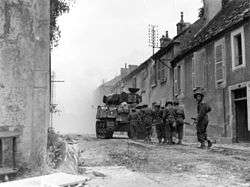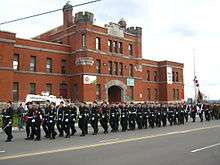Les Fusiliers de Sherbrooke
Les Fusiliers de Sherbrooke is a Primary Reserve infantry regiment of the Canadian Army. It is based in Sherbrooke, Quebec, with a sub-unit in Granby.
| Les Fusiliers de Sherbrooke | |
|---|---|
 The badge of Les Fusiliers de Sherbrooke. | |
| Active | 1910–present |
| Country | Canada |
| Branch | Canadian Army |
| Type | Primary Reserve infantry |
| Role | infantry |
| Size | Two companies and one regimental band |
| Part of | 35 Canadian Brigade Group |
| Garrison/HQ | Sherbrooke, Quebec |
| Motto(s) | Droit au but (To the point) |
| March | "Queen City" |
| Website | www |
Badge
A grenade with the Crown superimposed upon the ball within an annulet inscribed Les Fusiliers de Sherbrooke, surmounted by a beaver and super-imposed upon a maple leaf; the whole resting on a scroll inscribed Droit au but.[1]
Lineage
- Originated 1 April 1910 in Sherbrooke, Quebec as the 54th Regiment (Carabiniers de Sherbrooke)
- Redesignated 29 March 1920 as Les Carabiniers de Sherbrooke
- Redesignated 15 January 1933 as Les Fusiliers de Sherbrooke
- Redesignated 7 November 1940 as Les Fusiliers de Sherbrooke (Reserve)
- Redesignated 18 March 1942 as the 2nd (Reserve) Battalion, Les Fusiliers de Sherbrooke
- Redesignated 1 June 1945 as Les Fusiliers de Sherbrooke[2]
Common point of confusion
Early in World War II the Sherbrooke Fusiliers Regiment was formed with men from Les Fusiliers de Sherbrooke and The Sherbrooke Regiment. Shortly after establishment, the spelling was changed to "Fusilier", as in Sherbrooke Fusilier Regiment. This singular form of the name is on the cap badge and shoulder title. Its Royal Canadian Armoured Corps lineage, battle honours and armoured traditions are perpetuated by The Sherbrooke Hussars through The Sherbrooke Regiment. Les Fusiliers de Sherbrooke is an infantry regiment and shares the battle honours.
Further evidence of the singular form of the regimental name is found on the metal cap badge, which consists of a flaming grenade and a banner with the motto, "DROIT AU BUT" in French. The motto and the bomb were borrowed from Les Fusiliers de Sherbrooke. In the centre is a horse's head surrounded by the words "SHERBROOKE FUSILIER REGIMENT". The horse was found on the family coat of arms of Sir John Cope Sherbrooke, namesake of the home city.
The official Canadian Forces names must not be translated haphazardly. After GO 42/41 and GO 62/41, the name 'Fusiliers' changed from the plural to the singular 'Fusilier' form.[3] Therefore, only during 1940 was the regimental name plural. The foregoing as copied from official Department of National Defence references (A-DH-267-000/AF-003, page 2-2-67) accessed 21 Jun 14.
Perpetuations
The Great War
Operational history

The Great War
Details of the 54th Regiment "Carabiniers de Sherbrooke" were called out on active service on 6 August 1914 for local protection duties.[5]
The 163rd Battalion (French-Canadian), CEF was authorized on 22 December 1915 and embarked for Bermuda on 26 May 1916 for garrison duty. It sailed from Canada for Great Britain on 27 November 1916 where it was absorbed by the 10th Reserve Battalion, CEF, on 8 January 1917 to provide reinforcements for the Canadian Corps in the field. The battalion disbanded on 15 September 1917.[6]
The Second World War

Les Fusiliers de Sherbrooke, in conjunction with The Sherbrooke Regiment (Machine Gun) (now The Sherbrooke Hussars), mobilized The Sherbrooke Fusiliers Regiment, CASF for active service on 24 May 1940. The name Fusilier was plural initially but subsequently changed to singular. It was redesignated as the 1st Battalion, The Sherbrooke Fusiliers Regiment, CASF on 7 November 1940 and as the 1st Battalion, The Sherbrooke Fusilier Regiment, CASF on 15 November 1940. The 1st Battalion was converted to an armoured regiment on 26 January 1942 and designated as the 27th Armoured Regiment (The Sherbrooke Fusilier Regiment), CAC, CASF. By this time the name Fusilier was singular. It was redesignated as the 27th Armoured Regiment (The Sherbrooke Fusilier Regiment), RCAC, CASF on 2 August 1945. The regiment served in Newfoundland on garrison duty from 13 August 1941 to 15 February 1942, and embarked for Great Britain on 27 October 1942. On D-Day, 6 June 1944, it landed in Normandy, France as part the 2nd Canadian Armoured Brigade, and it continued to fight in North West Europe until the end of the war. The overseas regiment was disbanded on 15 February 1946.[7]
The regiment subsequently mobilized the 1st Battalion, Les Fusiliers de Sherbrooke, CASF' for active service on 18 March 1942. It served in Canada in a home defence role as part of the 15th Infantry Brigade, 7th Canadian Division and the 14th Infantry Brigade, 6th Canadian Division. Between September 30, 1942 and October 13, 1943, Les Fusiliers de Sherbrooke, CASF was stationed at Camp Debert, Nova Scotia.[8] On 10 January 1945, it embarked for Great Britain, where it was disbanded for reinforcements on 18 January 1945.[9]
Afghanistan
The regiment contributed an aggregate of more than 20% of its authorized strength to the various Task Forces which served in Afghanistan between 2002 and 2014.[10]
Regimental Band
The regimental band, known as the Musique des Fusiliers de Sherbrooke, had previously ended its operations in the 1970s before was recreated in the early 1990s by order of Lieutenant Colonel Pierre Véronneau, who was the regimental commander at the time. It has had a history than spans long before the creation of the regiment in 1910. The band's first director, Lieutenant Serge Bélanger, led the band with a small group of musicians, laid the foundations for the band to be significantly expanded to a 30-member force. It is currently one of nine military bands that are located in the province of Quebec. In 1996, Captain Sylvain Côté took over as director of music, a position he still holds today. The regimental band supports the personnel of the regiment for various ceremonies and parades, as well as units in Estrie.[11] The band also has engaged in many charity concerts in Quebec.[12] In April 2013, the band donated $2,000 to musical organizations in the region.[13]
Battle honours

In the list below, battle honours in small capitals were awarded for participation in large operations and campaigns, while those in lowercase indicate honours granted for more specific battles. Those battle honours in bold type are emblazoned on the regimental colour.[14]
The Second World War
- Normandy Landing
- Authie
- Caen
- The Orne
- Bourguébus Ridge
- Faubourg de Vaucelles
- St. André-sur-Orne
- Falaise
- Falaise Road
- Clair Tizon
- The Laison
- Antwerp–Turnhout Canal
- The Scheldt
- The Lower Maas
- The Rhineland
- The Hochwald
- Xanten
- The Rhine
- Emmerich–Hoch Elten
- Zutphen
- Deventer
- North-West Europe, 1944–1945[16]
Afghanistan Theatre Honour
- Afghanistan[17]
Notable personalities

Canada's leading tank ace Maj. (later Brig.-Gen.) S.V. Radley-Walters served as the Officer Commanding C Squadron of the 27th Armoured Regiment (The Sherbrooke Fusilier Regiment), RCAC, CASF. He would later serve as the first Commanding Officer of the Regular Army 8th Canadian Hussars (Princess Louise's), the Commandant of the Royal Canadian Armoured Corps School, Commander of 2 Combat Group at CFB Petawawa and Commander of the Combat Training Centre, Gagetown, NB.
Alliances
Armoury
| Site | Date(s) | Designated | Description | Image |
|---|---|---|---|---|
| Sherbrooke Armoury, 64 Belvédère street South, Sherbrooke, Quebec |
1908 | Canada's Register of Historic Places; Recognized - 1991 Register of the Government of Canada Heritage Buildings |
This large centrally located building with a low-pitched gable roof, has a large, unobstructed drill hall space |
 |
Les Fusiliers de Sherbrooke Regimental Museum
 | |
| Location | 64 Belvédère Street South Sherbrooke, Quebec Canada |
|---|---|
| Type | Regimental Museum |
The museum promotes the military history of Sherbrooke and the military history of Canada. The museum exhibits materials that relate to the regiment`s history, from its inception to the present. The museum collects, preserves, and shows, documents, artifacts and photos which illustrate the military life of other regiments and units.[18]
See also
External links
Order of precedence
| Preceded by The Calgary Highlanders |
Les Fusiliers de Sherbrooke | Succeeded by The Seaforth Highlanders of Canada |
References
- Canadian Forces Publication A-DH-267-003 Insignia and Lineages of the Canadian Forces. Volume 3: Combat Arms Regiments.
- Canadian Forces Publication A-DH-267-003 Insignia and Lineages of the Canadian Forces. Volume 3: Combat Arms Regiments.
- http://www.cmp-cpm.forces.gc.ca/dhh-dhp/his/ol-lo/vol-tom-3/par2/fs-eng.asp
- Canadian Forces Publication A-DH-267-003 Insignia and Lineages of the Canadian Forces. Volume 3: Combat Arms Regiments.
- Canadian Forces Publication A-DH-267-003 Insignia and Lineages of the Canadian Forces. Volume 3: Combat Arms Regiments.
- Canadian Forces Publication A-DH-267-003 Insignia and Lineages of the Canadian Forces. Volume 3: Combat Arms Regiments.
- Canadian Forces Publication A-DH-267-003 Insignia and Lineages of the Canadian Forces. Volume 3: Combat Arms Regiments.
- http://heritage.canadiana.ca/view/oocihm.lac_reel_t10563/1?r=0&s=1
- Canadian Forces Publication A-DH-267-003 Insignia and Lineages of the Canadian Forces. Volume 3: Combat Arms Regiments.
- "South-West Asia Theatre Honours". Archived from the original on May 12, 2014. Retrieved May 11, 2014.
- https://lecoeurenharmonie.ca/index.php/47-sylvain-cote/117-la-musique-des-fusiliers-de-sherbrooke
- http://m.estrieplus.com/contenu--1597-18122.html
- http://www.45enord.ca/2013/04/la-musique-des-fusiliers-de-sherbrooke-remet-2000-a-des-organismes-de-la-region/
- Canadian Forces Publication A-DH-267-003 Insignia and Lineages of the Canadian Forces. Volume 3: Combat Arms Regiments.
- Canadian Forces Publication A-DH-267-003 Insignia and Lineages of the Canadian Forces. Volume 3: Combat Arms Regiments.
- "Les Fusiliers de Sherbrooke". Official Lineages Volume 3, Part 2: Infantry Regiments. Directorate of History and Heritage. Retrieved 16 May 2014.
- "South-West Asia Theatre Honours". Office of the Prime Minister of Canada. Archived from the original on May 12, 2014. Retrieved 11 May 2014.
- A-AD-266-000/AG-001 Canadian Forces Museums –Operations and Administration 2002-04-03
| Wikimedia Commons has media related to Les Fusiliers de Sherbrooke. |